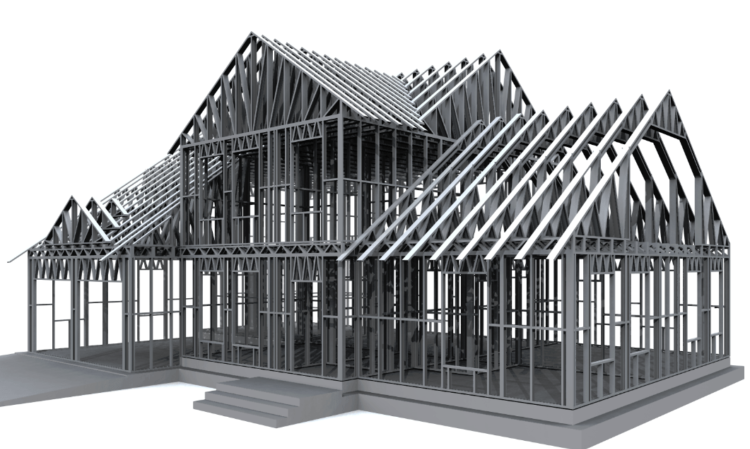COLD FORMED STEEL
What is Cold Formed Steel
Durable, Fire-Resistant, and Eco-Friendly: The Modern Choice for Strong and Efficient Construction
Cold-Form Steel is the common term for steel products shaped by cold-working processes carried out near room temperature, such as rolling, pressing and used in residential and commercial buildings up to 10 storey’s. Cold-formed steel has a lower cost to produce per unit than structural steel, made from recycled material and requires a smaller crew to install.

Because cold-formed steel (CFS) framing is lightweight, extremely strong, noncombustible, and relatively easy to install, it has dominated the market for interior, non-loadbearing partition walls in commercial construction. With advanced technological developments like panelized systems, the building community is now using CFS for structural applications in mid-rise and multi-housing buildings. In fact, cold-formed steel framing is rapidly becoming the material of choice for student dormitories, assisted living facilities, and hotels across the country, where prudent developers are interested in maximizing their return on investment.
What is Cold Formed Steel
Cold-formed steel (CFS) members are made from structural quality sheet steel that are formed into C-sections and other shapes by roll forming the steel through a series of dies. No heat is required to form the shapes (unlike hot-rolled steel), hence the name cold-formed steel. A variety of steel thicknesses are available to meet a wide range of structural and non-structural applications.
Value-Benefit of Steel
CFS as a construction material has many advantages. For example, CFS doesn’t shrink or split, won’t absorb moisture, and resists warping, termites, and fire. As a uniformly manufactured product, the quality of CFS is very consistent. That consistency translates into less scrap to haul off because there is less waste — all of it recyclable. In addition to lowering scrap disposal expenses, the fire resistance of CFS framing also can help reduce project costs through discounts on builders’ risk and construction insurance requirements.
CFS’ physical properties allow it to be used in a wide range of environments. Its strength and ductility, for example, make it ideal for construction in regions subject to high winds or earthquakes. Moreover, a study, conducted by the National Association of Home Builders (NAHB) Research Center, showed that the zinc coating on steel framing materials can protect against corrosion for hundreds of years. Because each piece of CFS contains a minimum of 25 percent recycled content, is 100 percent recyclable at the end of its lifespan, and emits no volatile organic compounds — it’s an exceptionally sustainable building material
On The Jobsite
Cold-formed steel (CFS) also provides numerous advantages in terms of the construction process itself. CFS is lightweight, making it easy to ship, handle, and assemble. Moreover, its greater strength means less material is required. For example, if a project calls for stick framing, the strength of CFS allows it to be installed on 24” centers rather than traditional 16” centers, resulting in fewer studs to install. Since CFS is manufactured to exacting standards, it is ideally suited for manufacturing into panels and trusses, which, because CFS is light in weight, can be quickly and easily installed with fewer framers on the job.
Given these advantages, some builders have found that ordering factory-manufactured steel panels and trusses is an ideal way to transition into steel framing. This approach minimizes the need for skilled framers and provides access to experienced design and layout professionals. In addition to speeding up the framing process, CFS panels contain pre-punched holes designed to accommodate rapid mechanical, electrical, and plumbing installations after the framing is complete.
Training
It is not difficult to train a crew to work with cold-formed steel (CFS). Experienced framers find it relatively easy to learn to frame with steel. Aside from applying their existing skills to a new set of framing components—such as steel C-section studs instead of wood studs, formed steel single tracks instead of top and bottom wood plates, and hex-, pan-, and bugle-head screws for framing in addition to pins (nails for steel connections)—framers only need to spend a bit of time mastering the use of a small number of new tools and fasteners.
The list of basic CFS framing tools is rather short. A typical toolset might include an adjustable-torque screw gun, bits and bit holders for structural steel-to-steel connections, a hand seamer for positioning and bending steel, a chop saw, a pneumatic pin-nailer for steel-to-steel connections and sheathing-to-steel connections, clamps, aviation snips, a swivel-head electric shear, and a magnetic level.
Wide Acceptance
With the adoption of the American Iron and Steel Institute’s North American Standards for Cold-Formed Steel Framing into the International Code Council’s International Building Codes, builders and designers can find comprehensive provisions for steel. These standards are also available as a free download from the American Iron and Steel Institute.